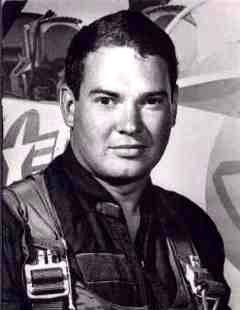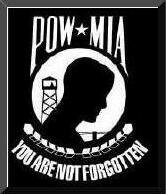LT.Dan Borah
![]()


Rank/Branch:Lieutenant/US Naval
Reserve
Unit: Attack Squadron 155, USS Oriskany (CV-34)
Date of Birth: 18 June 1946 (Olney, IL)
Home of Record: Olney, IL
Date of Loss: 24 September 1972
Country of Loss: South Vietnam
Status in 1973: Prisoner Of War
Category: 1
Aircraft/Vehicle/Ground: A7B Corsair
![]()
REMARKS: ALIVE IN CHUTE-NO MORE CONTACT
SYNOPSIS:The A7 Corsair was the US Navy's single seat,
light attack jet aircraft which featured advanced radar,
navigation and weapons systems,
and could carry a 15,000 pound bomb load.
The A7E with its more powerful TF-41 turbofan engine,
was the most advanced version of the Corsair to fly
combat missions in Southeast Asia.
The Corsair was also flown by Air Force and Marine air wings.
On 24
September 1972, Lt. Daniel V. Borah, Jr.,
pilot, launched from the deck of the USS Oriskany
as the flight leader in a flight of two aircraft on a
day strike mission against enemy targets located
in dense jungle approximately 15 miles south of the DMZ
and 23 miles east of the ill-defined South Vietnamese/Laotian border.
After crossing the Vietnamese coastline,
the Corsairs were directed to the target area
by the Forward Air Controller (FAC).
Their target included North Vietnamese Army (NVA) troops
who were entrenched in
bunkers roughly 13 miles west-northwest
of the city of Quang Tri and 25 miles west of the coastline,
Quang Tri Province, South Vietnam.
At 1350 hours,
and under the operational control of the
on-site Forward Air Controller (FAC), Lt. Borah and his
wingman began their initial bombing run as briefed.
Due to an improper switch setting, the wingman expended
his entire ordnance load on his first pass instead of the
several attack runs that had been planned.
He then proceeded to a holding position at 13,000 feet
over the target to observe Lt. Borah's succeeding bombing runs.
During Dan
Borah's second run, his aircraft was seen
to draw a barrage of 37mm anti-aircraft fire.
His wingman radioed for him to take evasive action,
then almost immediately saw the Corsair burst into flames.
The FAC saw Borah eject safely from the aircraft and
descend in a good parachute.
His wingman established emergency radio contact
with the downed pilot for 10-15 seconds after he safely
landed on the ground.
During his last voice contact, Dan Borah radioed:
"Gomer…all
around…"
While search and rescue (SAR) efforts commenced immediately,
no further contact could be established with him over the next two days.
On 26
September SAR operations were terminated.
Shortly thereafter, intelligence reports were received
by our government confirming that NVA soldiers
removed Lt. Borah's parachute from a tree within
30 minutes of his landing on the ground.
At the time SAR efforts were terminated,
Daniel V. Borah, Jr. was listed Missing in Action.
On 19 October
1972, the US government received information
that confirmed Daniel Borah had, in fact, been captured and
was a Prisoner of War. His status was immediately changed
from Missing In Action to Prisoner Of War,
and his family notified accordingly.
Problem is, he never came home.
In 1991, 17
color photographs depicting an
American Prisoner of War were taken in Laos
and brought to the US. After an extensive search
among POW/MIA families, Dan Borah's parents saw
the photos and immediately recognized their son.
To confirm the identity of Lt. Borah and the man in the 1991
photos to be one and the same, experts were asked to
compare those pictures with pre-capture family photos
of Dan Borah along with photos of other family members
which were used to aid in the identification process.
The results of those tests were positive.
In an attempt to discredit the 1991 photos and downplay
the live POW issue, the Laotian and US governments
rapidly produced a Laotian highland tribesman,
named "Mr. Ahroe." Both governments claimed he was
the man photographed in the now famous 1991 pictures,
and said the photos were part of an elaborate scheme to
swindle money from POW/MIA families.
Both governments also attempted to use this situation
to disprove the existence of living
Prisoners of War remaining in Southeast Asia today.
Again the
family took both the original 1991 photos
and the new pictures to experts in Still Digital Imaging
analysis to verify if they were pictures of the same man,
or as they believed, two different men.
The results of that study state:
"Both individuals are similar in basic appearance,
however upon concentrated examination it becomes
obvious that the similarity is just that: a similarity."
In November
1994, General James Wold, then
Director of the Defense POW/MIA Office (DPMO),
met with his Vietnamese counterpart, Mr. Cong,
of the Vietnam Office Seeking Missing Persons (VNOSMP).
During that meeting Gen. Wold was informed that
information on 5 cases, including that of Dan Borah,
would be provided by the end of the year.
On 14 August 1995, 8 months after that promise,
a Vietnamese witness was presented to US Officials.
Mr. Toan dutifully reported he knew of "a pilot who was
found dead in his parachute and buried nearby on 24 September 1972."
In early 1996,
rumors began to circulate in the
private sector about the remains of an American pilot
shot down late in the war in Quang Tri Province and
buried in full flight suit had been located and recovered.
Soon afterward the Borah family was notified that
Joint Task Force - Full Accounting (JTF-FA) had, indeed,
recovered a set of remains during the 40th Joint Field
Activity (23-31 March 1996), that the remains were found
in full flight suit including survival vest,
and that JTF-FA believed those remains belonged to Dan Borah.
His family also learned of Mr. Toan,
the Vietnamese witness who led JTF-FA investigators to the burial site.
During the
grave site excavation, JTF-FA personnel
recovered some 19 teeth, 3 long bones and various
unidentifiable bone chips and shards along with virtually
in tact clothing. All recovered material was transported
to the Central Identification Laboratory - Hawaii (CIL-HI) for
possible identification on 21 May 1997. CIL-HI determined
that due to the poor condition of the bones caused by many
years of being buried in acidic soil, none of them could
be used for anthropological analysis.
They did rule, however, upon thorough examination of
the 19 teeth, that all of them absolutely matched Lt. Borah's dental records.
The Borah
family requested an independent
analyses of CIL-HI's finding and was promptly,
forcefully and repeatedly informed by USG officials
the only way that would ever happen was if the family
accepted the remains - and thereby accepting their
positive identification of those remains as Dan Borah's - first.
If the family did not accept CIL-Hi's identification,
then the remains, flight suit, etc, would be placed in a box
on a shelf at CIL-HI and the family would never again have
access to them.
Further, the USG would publicly announce their findings
that Lt. Borah's remains were recovered and identified thereby
closing his case publicly as well as officially.
The family chose to secure the remains for further examination
and testing rather than allow the government to "win by default."
The results of their efforts
are truly astounding.
![]()
First, the
teeth may not all be from the same person.
One of them in particular
has a very pronounced shape that
is characteristic only of someone of American Indian ancestry.
Dan Borah has no American Indian in him. Also, according to
private sector experts, CIL-HI dental personnel ignored the fact
that their dental match was successful only if the teeth were
moved to the other side of the mouth. The family's dentist who
took care of the entire family retired years ago.
The family was successful in tracking down his records,
including x-rays, which had been archived. Interestingly,
all family members records were found intact except for the
Navy aviator's. The dental records provided by the USG are
suspect for many reasons not the least of which is none of the
normal personal data stenciled on the x-ray or x-ray sleeve is
present. Because of this, there is no way to know who those
x-rays actually belong to.
United States
Naval aviators traditionally fly in a one piece flight suit.
The "full flight suit" recovered with the remains from the grave site
in
Vietnam is not one piece, but rather a shirt and pants.
Dan Borah weighed 200 pounds and was prone to easy weight gain.
His family always teased him about his ability to fit into a
jet fighter's cockpit.
To quote Lt. Borah's sister who is much smaller than he was,
"the pants would barely fit me. They would never fit him."
Further, all rank designations, unit patches and the American flag
that at one time had been sewn onto this garment had been carefully
cut off making it impossible to determine any real connection
between this "flight suit" and its' owner.
CIL-HI experts stated that the acidic soil of Vietnam is what
destroyed the bones making them useless for identification purposes.
That same soil should have totally destroyed the much more flimsy
material of the flight suit, with the possible exception of the zippers,
that Dan Borah was supposedly buried in.
Again, according to Lt. Borah's sister, today
"you could put that flight suit on and wear it on the street.
It looks no worse than if it had been attacked by angry moths
in the back of a closet."
Based on the
USG's own intelligence records dating
from the date of incident, there is no question Dan Borah
was captured alive and held prisoner by communist forces.
The real question today is:
Is he still surviving in spite of the USG's claims to the contrary?
Since the end
of the Vietnam War well over 21,000 reports
of American prisoners, missing and otherwise unaccounted
for have been received by our government.
Many of these reports document LIVE America
Prisoners of War remaining captive throughout Southeast Asia TODAY.
Fighter pilots
were called upon to fly in many
dangerous circumstances, and they were
prepared to be wounded, killed or captured.
It probably never occurred to them that they
could be abandoned by the country they so proudly served.
While the USG
considers Dan Borah to be "remains returned,"
his family does not.
They ask that Americans continue to wear his POW/MIA bracelets
and help them fight for an honorable accounting for him.

![]()
Just Click on
the Dog Tags to be taken to my Welcome Page
Follow the Dog Tags on to my Menu Page....
The Dog Tags lead the way.......